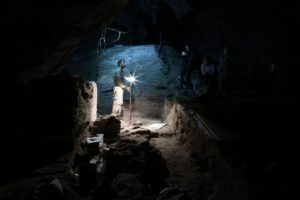
AMERICAN ASSOCIATION FOR THE ADVANCEMENT OF SCIENCE—A comprehensive, hemisphere-spanning study of ancient DNA suggests a highly complex peopling of the American continents – one that cannot be explained by simple models or patterns of dispersal. The study involved an analysis of ancient American genomes unearthed in locations spanning from Alaska to Patagonia. While there has been much focus on the timing and number of initial migrations into North and South America, less attention has been paid to the subsequent expansion throughout the American continents. Previous genomic studies have suggested that the first American populations diverged from their Siberian and East Asian ancestors nearly 25,000 years ago, and subsequently split into distinct North American and South American populations about 10,000 years later. However, the expansion of the first Americans remains a contentious topic and has been difficult to understand from analysis of present-day populations. Víctor Moreno-Mayar and colleagues sequenced the genomes of 15 ancient Americans from locations spanning the Americas, and six of which were more than 10,000 years old. The results reveal a complex picture of population expansion and diversification. According to Moreno-Mayar et al., people spread out rapidly, yet unevenly, throughout the Americas, and diversified into multiple populations, some of which were unknown before this analysis -visible only in the genetic record. Interestingly, the authors identified the presence of a Late Pleistocene (about 11,700 BP) population with Australasian ancestry evident only in South America, which left no apparent genetic traces in North America. In addition, the authors find evidence of a smaller Mesoamerican-related population expansion evident through a geographically widespread admixture of genetic material. While the study’s results fill some gaps in our understanding of early Americans and reveal a complex population history, the authors note that the peopling of the Americas is likely more complicated still, as evidenced by the identification of unknown groups here.
Clovis, Genetic Exchanges, and Population Turnover in Central and South America
HARVARD MEDICAL SCHOOL—The international team of researchers revealed unexpected details about the peopling of Central and South America by studying the first high-quality ancient DNA data from those regions.
The findings include two previously unknown genetic exchanges between North and South America, one of which represents a continent-wide population turnover.
The results suggest that the people who spread the Clovis culture, the first widespread archaeological culture of North America, had a major demographic impact further south than previously appreciated.
The authors analyzed genome-wide data from 49 individuals from Central and South America, some as old as 11,000 years. Previously, the only genomes that had been reported from this region and that provided sufficient quality data to analyze were less than 1,000 years old.
By comparing ancient and modern genomes from the Americas and other parts of the globe, the researchers were able to obtain qualitatively new insights into the early history of Central and South America.
Published in the journal Cell, the study was led by researchers at Harvard Medical School; the Howard Hughes Medical Institute; the Max Planck Institute for the Science of Human History; the University of California, Santa Cruz; Pennsylvania State University; the University of New Mexico; the University of São Paulo and other institutions in Argentina, Australia, Belize, Brazil, Chile, the European Union, Peru and the United States.
The researchers obtained official permits to excavate and conduct analysis on ancient human remains and consulted with local governmental agencies and indigenous communities.
________________________________
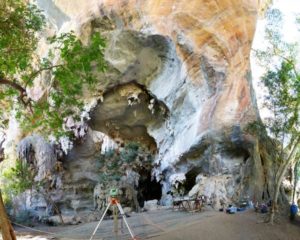
The exterior of the rock shelter site of Lapa do Santo in Brazil. André Strauss
________________________________

Excavation in progress at the rock shelter site of Lapa do Santo in Brazil, where an individual dating to approximately~9,600 years ago was found. AndréStrauss
________________________________
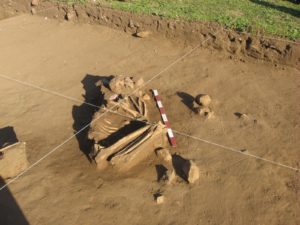
This individual from the site of Los Rieles in Chile is the oldest in the study at ~11,000 years ago. Bernardita Ladrón de Guevara, 2008
________________________________
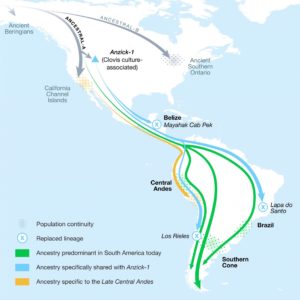
Graphic showing the geographic movement of populations discussed in the study. Graphic: Michelle O’Reilly; Posth, Nakatsukaet al. 2018. Reconstructing the Deep Population History of Central and South America. Cell.
________________________________
Clovis link in the oldest Central and South Americans
A distinctive DNA type associated with the Clovis culture was found in Chile, Brazil and Belize 11,000 to 9,000 years ago.
“A key discovery was that a Clovis culture-associated individual from North America dating to around 12,800 years ago shares distinctive ancestry with the oldest Chilean, Brazilian and Belizean individuals,” said co-lead author Cosimo Posth of the Max Planck Institute for the Science of Human History. “This supports the hypothesis that the expansion of people who spread the Clovis culture in North America also reached Central and South America.”
However, the Clovis culture-associated lineage is missing in present-day South Americans and in ancient samples that are less than 9,000 years old.
“This is our second key discovery,” said co-senior author David Reich, professor of genetics at Harvard Medical School and a Howard Hughes Medical Institute investigator. “We have shown that there was a continent-wide population replacement that began at least 9,000 years ago.”
After the population replacement, there was striking genetic continuity between ancient individuals dating to up to 9,000 years ago and modern people from multiple South American regions. This contrasts with West Eurasia and Africa, where there are few places with such long-standing continuity.
California Channel Island-associated ancestry in the Andes
The second previously unknown spread of people revealed itself in an analysis showing that ancient Californians from the Channel Islands have a distinctive shared ancestry with groups that became widespread in the southern Peruvian Andes by at least 4,200 years ago.
The researchers say this is unlikely to reflect population spread specifically from the Channel Islands into South America. Instead, they hypothesize that the connection between these regions is the result of expansions of people that occurred thousands of years earlier, and that such ancestry became more widespread in the Andes after subsequent events within South America.
“It could be that this ancestry arrived in South America thousands of years before and we simply don’t have earlier individuals showing it,” said Nathan Nakatsuka, a research assistant in the Reich lab at Harvard Medical School and co-lead author of the study. “There is archaeological evidence that the population in the Central Andes area greatly expanded after around 5,000 years ago. Spreads of particular subgroups during these events may be why we detect this ancestry afterward.”
The promise of ancient DNA research in the Americas
The researchers emphasize that their study gives only a glimpse of the discoveries that may come through future work.
To learn about the initial movements of people into Central and South America, they say, it would be necessary to obtain ancient DNA from individuals dating to before 11,000 years ago.
Even for the period between 11,000 and 3,000 years ago that this study focused on, the picture is far from complete.
“We lacked ancient data from Amazonia, northern South America and the Caribbean, and thus cannot determine how individuals in these regions relate to the ones we analyzed,” said Reich. “Filling in these gaps should be a priority for future work.”
“We are excited about the potential of research in this area,” said co-senior author Johannes Krause of the Max Planck Institute for the Science of Human History. “With future regionally-focused studies with large sample sizes, we could realize the potential of ancient DNA to reveal how the human diversity of this region came to be the way it is today.”
An Ancient Child’s Tooth and Early Alaskan Inhabitants
UNIVERSITY OF ALASKA FAIRBANKS—Recent research on a newly rediscovered 9,000-year-old child’s tooth has reshaped our understanding of Alaska’s ancient people, their genetic background and their diets.
The tooth is only the second known remnant of a population of early migrants known as Ancient Beringians. Combined with previous University of Alaska Fairbanks research, the find indicates that Ancient Beringians remained in Alaska for thousands of years after first migrating across the Bering Land Bridge that connected eastern Asia and Alaska.
Investigation of the tooth, conducted by researchers at UAF and the National Park Service in Alaska, was part of a larger study documented by a paper published Nov. 8 in the journal Science. That research included genetic analysis of 15 diverse bone samples from sites across North and South America, revealing a broad picture of how the Americas were populated by its earliest peoples.
The Alaska tooth had been largely forgotten since it was excavated in 1949 by Danish archaeologists from the Trail Creek Caves site on Alaska’s Seward Peninsula. For almost 70 years it remained in storage in Copenhagen, Denmark, until it was found in 2016 by Jeff Rasic, a Fairbanks-based NPS archaeologist who was conducting new analyses of this old collection.
Radiocarbon dating determined the tooth, which belonged to a 1½-year-old child, is by far the oldest human specimen in the North American Arctic—more than twice as old as the next oldest remains. Genomic testing connected the tooth to the Ancient Beringian lineage. The only other trace of that population was discovered in 2013 by a team led by UAF associate professor Ben Potter at a site in Alaska’s Interior.
When looked at together, those two sites—separated by about 400 miles and 2,500 years—show that Ancient Beringians were present across the vast expanse of Alaska for millennia.
“This one small tooth is a treasure trove of information about Alaska’s early populations, not only their genetic affinities but also their movements, interactions with other people and diet,” said Rasic.
Researchers worked with tribal officials from the Seward Peninsula village of Deering to coordinate efforts to study the tooth.
Analysis at UAF’s Alaska Stable Isotope Facility also revealed surprising details about the lives of the child and, by proxy, the mother who fed the child. By studying chemical signatures preserved in the tooth, ASIF Director Matthew Wooller was able to analyze their diet.
“The child’s food sources were entirely terrestrial, a sharp contrast with other sites that indicate inclusion of anadromous fish and marine resources.” Wooller said.
That land-based diet is a surprise—during the time the child lived on the Seward Peninsula, sea levels had risen to nearly modern levels. Those rising waters had cut off the Bering Land Bridge and surrounded most of the peninsula, making marine resources accessible.
Further isotope results and modeling, which were conducted by Rasic, Wooller and Clement Bataille from the University of Ottawa, also determined the family resided in the region surrounding the caves, and were not migrants from elsewhere in Alaska or Siberia.
“The combination of isotope signatures found in the tooth is pretty specific to the interior Seward Peninsula, making a local origin for the family very probable,” Bataille said.
______________________________
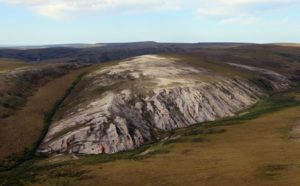
An aerial view of the Trail Creek Caves site on Alaska’s Seward Peninsula. Analysis of a 9,000-year-old tooth from the site has broadened understanding of Alaska’s early inhabitants. NPS photo by Jeff Rasic
______________________________
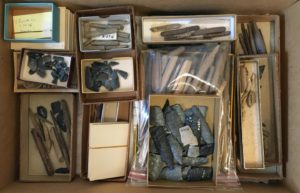
Artifact collections from Helge Larsen’s 1949-50 excavations from the Trail Creek Caves site, housed at the Danish National Museum in Copenhagen, Denmark. NPS photo by Jeff Rasic
______________________________
Early Settlement and Survival in the Andean Highlands
UNIVERSITY OF CHICAGO MEDICAL CENTER—A multi-center study of the genetic remains of people who settled thousands of years ago in the Andes Mountains of South America reveals a complex picture of human adaptation from early settlement, to a split about 9,000 years ago between high and lowland populations, to the devastating exposure to European disease in the 16th-century colonial period.
Led by Anna Di Rienzo, PhD, and John Lindo, PhD, JD, from the University of Chicago; Mark Aldenderfer, PhD, from the University of California, Merced; and Ricardo Verdugo from the University of Chile, the researchers used newly available samples of DNA from seven whole genomes to study how ancient Andean people—including groups that clustered around Lake Titicaca in Peru and Bolivia, 12,000 feet above sea level—adapted to their environment over the centuries.
In the journal Science Advances, they compared their seven historical genomes to 64 modern-day genomes from a current highland Andean population, the agropastoral Aymara of Bolivia, and the lowland hunter-gatherer Huilliche-Pehuenche in coastal Chile.
The goals were (1) to date the initial migration to the Andean highlands, (2) to identify the genetic adaptations to the high-altitude environment that allowed that settlement, (3) to estimate the impact of the European contact starting in the 1530s that caused the near annihilation of many lowland communities of South America.
“We have very ancient samples from the high Andes,” said Di Rienzo. “Those early settlers have the closest affinity to the people who now live in that area. This is a harsh, cold, resource-poor environment, with low oxygen levels, but people there adapted to that habitat and the agrarian lifestyle.”
The study, “The Genetic prehistory of the Andean highlands 7,000 years BP through European contact,” uncovered several unexpected features.
The researchers found that highland Andeans experienced much smaller than expected population declines following contact with European explorers who first came to South America in the 1530s. In the lowlands, demographic modeling and historical records infer that up to 90 percent of residents may had been wiped out after the arrival of Europeans. But the people living in the upper Andes had only a 27-percent population reduction.
Even though the highlanders lived in altitudes above 8,000 feet, which meant reduced oxygen, frequent frigid temperatures and intense ultra-violet radiation, they did not develop the responses to hypoxia seen in natives of other high-altitude settings, such as Tibet.
The Andeans may have adapted to high altitude hypoxia “in a different way, via cardiovascular modifications,” the researchers suggest. They found evidence of alterations in a gene called DST, which is associated with the formation of cardiac muscle. Andean highlanders tend to have enlarged right ventricles. This may have improved oxygen intake, enhancing blood flow to the lungs.
But the strongest adaptation signal the researchers found was in a gene called MGAM (maltase-glucoamylase) an intestinal enzyme. It plays an important role in the digestion of starchy foods such as potatoes—a food native to the Andes. A recent study suggests that the potato may have been domesticated in the region at least 5,000 years ago. Positive selection on the MGAM gene, the authors note, “may represent an adaptive response to greater reliance upon starchy domesticates.”
The early presence of this variant in Andean peoples suggests “a significant shift in diet from one that was likely more meat based to one more plant based,” said UC Merced’s Aldenderfer, an anthropologist. “The timing of the appearance of the variant is quite consistent with what we know of the paleo-ethno-botanical record in the highlands.”
Although Andean settlers consumed a high-starch diet after they started to farm, their genomes did not develop additional copies of the starch related amylase gene, commonly seen in European farming populations.
A comparison of the ancient genomes with their living descendants also revealed selection for immune-related genes soon after the arrival of Europeans, suggesting that Andeans who survived may have had an advantage with regard to the newly introduced European pathogens.
“Contact with Europeans had a devastating impact on South American populations, such as the introduction of disease, war, and social disruption,” explained Lindo. “By focusing on the period before that, we were able to distinguish environmental adaptations from adaptations that stemmed from historical events.”
“In our paper,” said Aldenderfer, “there was none of this prioritization of genes at the expense of archaeological data. We worked back and forth, genetics and archaeology, to create a narrative consistent with all of the data at hand.”
___________________________
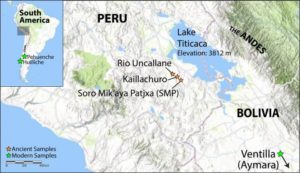
Location of ancient samples near Lake Titicaca, elevation 3812 meters, in what is now Peru and Bolivia. Authors of the study
___________________________
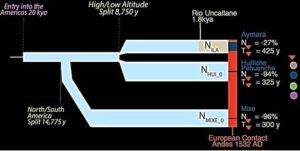
Entry into the Americas 20 ka ago. High/low altitude split 8750 years. European contact 1532 AD. Study authors
___________________________
The Oldest Natural Mummy, Paleoamericans, and Australasians
ST JOHN’S COLLEGE, UNIVERSITY OF CAMBRIDGE—A legal battle over a 10,600 year old ancient skeleton – called the ‘Spirit Cave Mummy’ – has ended after advanced DNA sequencing found it was related to a Native American tribe.
The revelation was published in Science as part of the wide-ranging international study that genetically analyzed the DNA of a series of famous and controversial ancient remains across North and South America, including Spirit Cave, the Lovelock skeletons, the Lagoa Santa remains, an Inca mummy, and the oldest remains in Chilean Patagonia. This study also looked at the second oldest human remains from Trail Creek Cave in Alaska – the 9,000 year old milk tooth from a young girl [related previously above].
The team of academics not only discovered that the Spirit Cave remains – the world’s oldest natural mummy – was a Native American but they were able to dismiss a longstanding theory that a group called Paleoamericans existed in North America before Native Americans.
The ground-breaking research also discovered clues of a puzzling Australasian genetic signal in the 10,400 year old Lagoa Santa remains [as mentioned previously above] from Brazil, revealing a previously unknown group of early South Americans – but the Australasian link left no genetic trace in North America. It was described by one of the scientists as ‘extraordinary evidence of an extraordinary chapter in human history’.
Professor Eske Willeslev, who holds positions both at St John’s College, University of Cambridge, and the University of Copenhagen, and led the study, said: “Spirit Cave and Lagoa Santa were very controversial because they were identified as so-called ‘Paleoamericans’ based on craniometry – it was determined that the shape of their skulls was different to current day Native Americans. Our study proves that Spirit Cave and Lagoa Santa were actually genetically closer to contemporary Native Americans than to any other ancient or contemporary group sequenced to date.”
The Lagoa Santa remains were retrieved by Danish explorer Peter W. Lund in the 19th century and his work led to this ‘Paleoamerican hypothesis’ based on cranial morphology that theorized the famous group of skeletons could not be Native Americans. But this new study disproves that theory and the findings were launched under embargo by Professor Willeslev with representatives from the Brazilian National Museum in Rio on Tuesday, November 6 2018.
He added: “Looking at the bumps and shapes of a head does not help you understand the true genetic ancestry of a population – we have proved that you can have people who look very different but are closely related.”
The scientific and cultural significance of the Spirit Cave remains, which were found in 1940 in a small rocky alcove in the Great Basin Desert, was not properly understood for 50 years. The preserved remains of the man in his forties were initially believed to be between 1,500 and 2000 years old, but during the 1990s new textile and hair testing dated the skeleton at 10,600 years old.
The Fallon Paiute-Shoshone Tribe, a group of Native Americans based in Nevada near Spirit Cave, claimed cultural affiliation with the skeleton and requested immediate repatriation of the remains under the Native American Graves Protection and Repatriation Act.
The request was refused because the ancestry was disputed, the tribe sued the federal government and the lawsuit pitted tribal leaders against anthropologists, who argued the remains provided invaluable insights into North America’s earliest inhabitants and should continue to be displayed in a museum.
The deadlock continued for 20 years until the tribe agreed that Professor Willeslev could carry out genome sequencing on DNA extracted from the Spirit Cave for the first time.
Professor Willeslev said: “I assured the tribe that my group would not do the DNA testing unless they gave permission and it was agreed that if Spirit Cave was genetically a Native American the mummy would be repatriated to the tribe.”
The team painstakingly extracted DNA from the petrus bone from the inside of the skull, proving that the skeleton was an ancestor of present day Native Americans. Spirit Cave was returned to the tribe in 2016 and there was a private reburial ceremony earlier this year that Professor Willeslev attended and details have just been released.
The geneticist explained: “What became very clear to me was that this was a deeply emotional and deeply cultural event. The tribe have real feelings for Spirit Cave, which as a European it can be hard to understand but for us it would very much be like burying our mother, father, sister or brother.
“We can all imagine what it would be like if our father or mother was put in an exhibition and they had that same feeling for Spirit Cave. It has been a privilege to work with them.”
The tribe was kept informed throughout the two year project and two members visited the lab in Copenhagen to meet the scientists and they were present when all of the DNA sampling was taken.
According to a statement from the Fallon Paiute-Shoshone Tribe: “The Tribe has had a lot of experience with members of the scientific community, mostly negative. However, there are a handful of scientists that seemed to understand the Tribe’s perspective and Eske Willerslev was one of them.
“He took the time to acquaint himself with the Tribe, kept us well-informed of the process, and was available to answer our questions. His new study confirms what we have always known from our oral tradition and other evidence – that the man taken from his final resting place in Spirit Cave is our Native American ancestor.”
The genome of the Spirit Cave skeleton has wider significance because it not only settled the legal and cultural dispute between the tribe and the Government, it also helped reveal how ancient humans moved and settled across the Americas. The scientists were able to track the movement of populations from Alaska to as far south as Patagonia. They often separated from each other and took their chances traveling in small pockets of isolated groups.
Dr David Meltzer, from the Department of Anthropology, Southern Methodist University, Dallas, said: “A striking thing about the analysis of Spirit Cave and Lagoa Santa is their close genetic similarity which implies their ancestral population traveled through the continent at astonishing speed. That’s something we’ve suspected due to the archaeological findings, but it’s fascinating to have it confirmed by the genetics. These findings imply that the first peoples were highly skilled at moving rapidly across an utterly unfamiliar and empty landscape. They had a whole continent to themselves and they were traveling great distances at breath-taking speed.”
The study also revealed surprising traces of Australasian ancestry in ancient South American Native Americans but no Australasian genetic link was found in North American Native Americans. Dr Victor Moreno-Mayar, from the Centre for GeoGenetics, University of Copenhagen and first author of the study, said: “We discovered the Australasian signal was absent in Native Americans prior to the Spirit Cave and Lagoa Santa population split which means groups carrying this genetic signal were either already present in South America when Native Americans reached the region, or Australasian groups arrived later. That this signal has not been previously documented in North America implies that an earlier group possessing it had disappeared or a later arriving group passed through North America without leaving any genetic trace.”
Dr Peter de Barros Damgaard, from the Centre for GeoGenetics, University of Copenhagen, explained why scientists remain puzzled but optimistic about the Australasian ancestry signal in South America. He explained: “If we assume that the migratory route that brought this Australasian ancestry to South America went through North America, either the carriers of the genetic signal came in as a structured population and went straight to South America where they later mixed with new incoming groups, or they entered later. At the moment we cannot resolve which of these might be correct, leaving us facing extraordinary evidence of an extraordinary chapter in human history! But we will solve this puzzle.”
___________________________
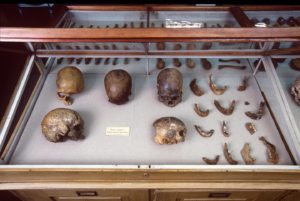
Skulls and other human remains from P.W. Lund’s Collection from Lagoa Santa, Brazil kept in the Natural History Museum of Denmark. Natural History Museum of Denmark
___________________________
Article Sources: AAAS Science Advances, Harvard Medical School, University of Alaska Fairbanks, and University of Chicago Medical Center. and St. John’s College news releases
___________________________
If you liked this article, you may like The Girl in the Cave, a free premium article previously published in Popular Archaeology about the spectacular discovery of the remains of an ancient girl within a submerged cave in Mexico.





